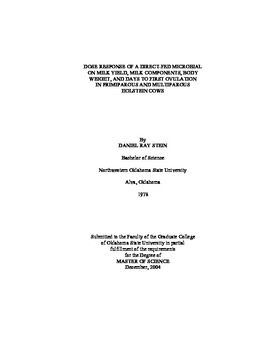| dc.contributor.author | Stein, Daniel R. | |
| dc.date.accessioned | 2014-04-15T20:13:10Z | |
| dc.date.available | 2014-04-15T20:13:10Z | |
| dc.date.issued | 2004-12-01 | |
| dc.identifier.uri | https://hdl.handle.net/11244/8870 | |
| dc.description.abstract | This study was conducted to investigate whether manipulating ruminal fermentation with propionibacteria would result in positive economic impact on milk production, milk components, and improved reproductive efficiency in dairy cows. From two wk prior to parturition to 175 d postpartum, 38 primi- and multiparous Holstein cows were assigned to three treatment groups: Control (n = 13) received Total Mixed Ration (TMR); Low-dose treatment (n = 14) received control TMR plus 6 x 1010 cfu/head Propionibacteria Strain P169 (P169); High-dose treatment (n = 11) received control TMR plus 6 x 1011 cfu/head P169. P169 was fed daily (p.m.) as a top-dress on 4.5 kg of TMR. Cows were milked twice daily. Twice weekly milk samples were analyzed for percentage milk fat, protein, lactose, and solids-not-fats (SNF), milk urea nitrogen (MUN) and somatic cell count (SCC). Rumen fluid was collected at 30 d prepartum, and at d 60, 120, and 175 postpartum. Daily 4% fat-corrected milk (FCM) production was affected by treatment and week x parity. High-dose and Low-dose P169 treatments exhibited a 7.1 % and 8.5 % increase in daily 4% FCM production vs. Control, respectively. Treatment x parity and week influenced percentage milk fat, lactose, and protein, where High-dose P169 decreased milk fat percentage and increased milk lactose and protein percentage vs. Control. SNF was influenced by treatment x parity and treatment x week. Propionate levels and acetate/propionate ratio were influenced by treatment such that High-dose P169 had an 18.5% and 17.0% increase in molar percent ruminal propionate over the Low-dose P169 and Control, respectively, with High-dose P169 having a 15.41% and 13.33% decrease in the acetate/ propionate ratio from Low-dose P169 and Control, respectively. Change in body weight from wk 1 was influenced by week x parity and treatment x parity. High-dose and Low-dose P169 multiparous cows had a greater recovery of wk 1 body weight vs. Control. No treatment, parity, or interaction on days to first ovulation after parturition was observed. We conclude P169 may hold potential as an effective direct-fed microbial to increase milk production. | |
| dc.format | application/pdf | |
| dc.language | en_US | |
| dc.publisher | Oklahoma State University | |
| dc.rights | Copyright is held by the author who has granted the Oklahoma State University Library the non-exclusive right to share this material in its institutional repository. Contact Digital Library Services at lib-dls@okstate.edu or 405-744-9161 for the permission policy on the use, reproduction or distribution of this material. | |
| dc.title | Dose Response of a Direct-fed Microbial on Milk Yield, Milk Components, Body Weight, and Days to First Ovulation in Primiparous and Multiparous Holstein | |
| dc.type | text | |
| osu.filename | Stein_okstate_0664M_1207.pdf | |
| osu.college | Agricultural Sciences and Natural Resources | |
| osu.accesstype | Open Access | |
| dc.description.department | Department of Animal Science | |
| dc.type.genre | Thesis | |
| dc.subject.keywords | propionibacteria | |
| dc.subject.keywords | direct-fed microbial | |
| dc.subject.keywords | milk production | |
| dc.subject.keywords | vfa | |
